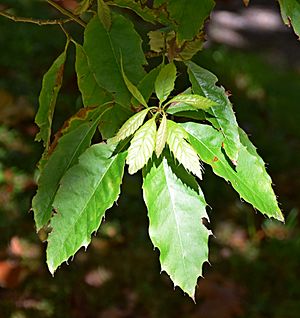Xalapa oak facts for kids
Quick facts for kids Xalapa oak |
|
|---|---|
 |
|
| Conservation status | |
| Scientific classification | |
| Genus: |
Quercus
|
| Species: |
xalapensis
|
| Synonyms | |
|
List
Quercus cupreata Trel. & C.H.Müll.
Quercus cupreata f. brachystachys C.H.Mull. Quercus cupreata f. serrata Trel. & C.H.Müll. Quercus huitamalcana Trel. Quercus serra Liebm. 1854 not Unger 1845 Quercus sierramadrensis C.H.Mull. Quercus tenuiloba C.H.Mull. Quercus tenuiloba f. gracilis C.H.Müll. Quercus tenuiloba f. hirsuta C.H.Müll. Quercus vexans Trel. Quercus xalapensis f. jalapae Trel. Quercus xalapensis f. surculina Trel. |
|
The xalapa oak, also known by its scientific name Quercus xalapensis, is a type of oak tree. It belongs to the group of red oaks. This tree grows naturally in the mountains of eastern and southern Mexico. You can also find it in Guatemala, Honduras, and Nicaragua in Central America.
Contents
What Does the Xalapa Oak Look Like?
The xalapa oak is a very large tree. Its main trunk can be about 40 to 80 centimeters (16 to 31 inches) wide.
Leaves of the Xalapa Oak
The leaves of the xalapa oak are shaped like a spearhead. They can grow up to 10 centimeters (4 inches) long. The edges of the leaves have many sharp points, like teeth. Each point ends in a long, thin tip.
Where Does the Xalapa Oak Grow?
The xalapa oak lives in the mountain areas of eastern and southern Mexico. It also grows in northern Central America.
Mountain Homes of the Xalapa Oak
In Mexico, you can find this tree in several mountain ranges. These include the Sierra Madre Oriental, the Sierra Madre de Oaxaca, and the eastern Sierra Madre del Sur. It also grows in the Sierra de los Tuxtlas, the Chiapas Highlands, and the Sierra Madre de Chiapas. Further south, it is found in the Chortis Highlands of Honduras and Nicaragua.
Preferred Environment and Neighbors
This oak tree grows in different types of forests. It lives in oak forests, Abies (fir) forests, and cloud forests. It prefers to grow at high elevations, between 1,070 and 2,000 meters (3,510 and 6,560 feet) above sea level.
The xalapa oak likes shallow soils. It also grows well in sandy soils that are a bit acidic. This tree does not like a lot of shade. It grows best in open areas of the forest. Young xalapa oak trees can be found in forest clearings. They can even be planted in old pastures.
Other plants often grow near the xalapa oak. These include epiphytic orchids and bromeliads. Other trees that grow with it are Carya ovata (shagbark hickory), Persea liebmannii, Quercus muehlenbergii (chinkapin oak), Quercus polymorpha, and Pinus pseudostrobus (Mexican yellow pine).
See also
 In Spanish: Quercus xalapensis para niños
In Spanish: Quercus xalapensis para niños


